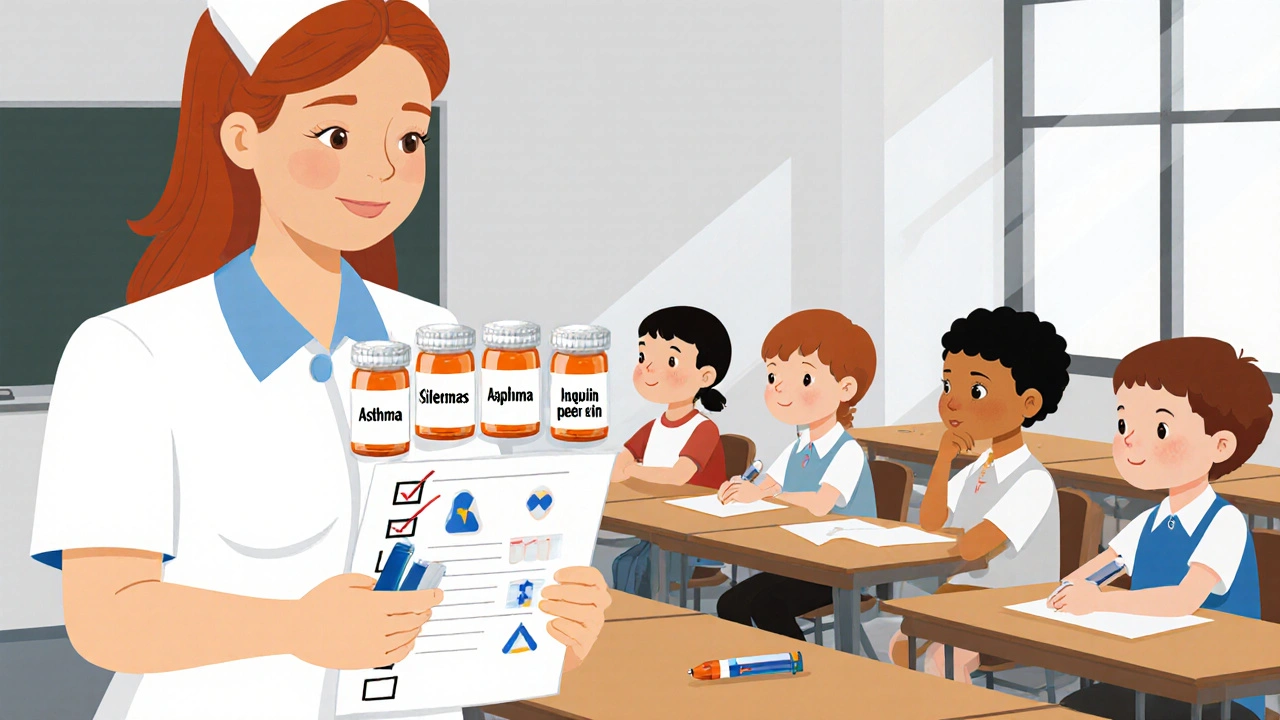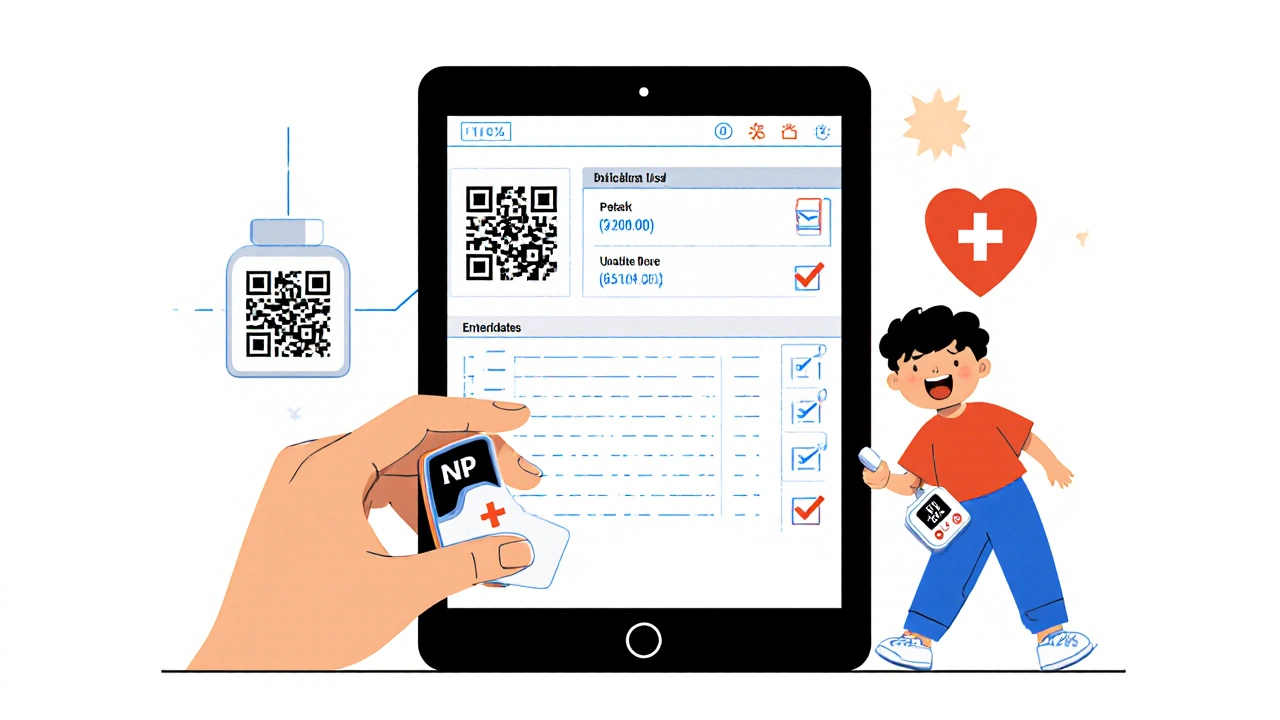How to Coordinate School Nurses for Daily Pediatric Medications
 Nov, 25 2025
Nov, 25 2025
Every morning, hundreds of thousands of children across the U.S. swallow pills, use inhalers, or get insulin shots-not at home, but in the classroom. For many of these kids, school is where their daily medication happens. And if it’s not done right, the consequences can be serious: missed doses, dangerous reactions, or even life-threatening errors. The person holding it all together? The school nurse.
Why School Nurses Are the Backbone of Pediatric Medication Safety
School nurses aren’t just there for Band-Aids and headaches. They’re the only licensed medical professionals on-site who can legally assess, delegate, and supervise medication administration. For a child with asthma, diabetes, epilepsy, or ADHD, school is where their treatment plan must continue without interruption. Without a coordinated system, these kids are at risk. The National Association of School Nurses (NASN) laid out the gold standard in 2022: every medication given at school must follow the Five Rights-right student, right medication, right dose, right route, right time. It sounds simple. But in a busy school with 30 kids needing different meds at different times, it’s anything but easy. A 2023 study found that 1.2% of school-based medication administrations contain errors. That might sound small, but in a district with 10,000 students, that’s over 120 mistakes a year. Most happen because someone skipped a step-maybe a teacher gave the wrong pill because the label was faded, or a nurse was pulled away during a fire drill and forgot to double-check the name.The Legal Framework: What Schools Must Follow
Schools don’t get to make up their own rules. Federal laws like Section 504 of the Rehabilitation Act and the Individuals with Disabilities Education Act (IDEA) require schools to provide necessary medical services for students with disabilities. That includes daily medications. If a school fails to comply, they risk losing federal funding-like Houston ISD did in 2022, when they were fined $2.3 million for medication administration failures. Each state also has its own Nurse Practice Act, which defines what nurses can and can’t do. In 37 states, school nurses can train unlicensed staff-like teachers or aides-to give certain medications under direct supervision. But in others, only the nurse can do it. This patchwork system creates confusion. A nurse moving from Virginia to Texas might find their protocols completely different. Texas, for example, treats medication administration as an administrative task, not a nursing function. That sounds efficient-but it’s risky. A 2022 legal analysis found districts using this model had 14% higher liability risk. Why? Because when a principal overrides a nurse’s judgment about a child’s condition, someone’s legally responsible if something goes wrong.The 7-Step Coordination System That Works
The most successful schools don’t wing it. They follow a clear, step-by-step process backed by NASN’s Implementation Toolkit:- Develop a district-wide policy. Use sample templates from NASN. Don’t create one from scratch-it takes 8-12 weeks to get approval, but you’ll avoid legal headaches later.
- Train all school nurses. They need a 16-hour certification course on delegation, documentation, and state laws. Nurses who skip this are flying blind.
- Screen every student. Use a three-category system: Nurse Dependent (needs full help), Supervised (needs reminders), Self-Administered (can do it alone, with approval). Don’t assume a child can handle their own meds just because they’re older.
- Create Individualized Healthcare Plans (IHPs). These aren’t paperwork-they’re living documents. For a child with type 1 diabetes, the IHP includes insulin timing, blood sugar targets, symptoms of low glucose, and emergency contacts. Each one takes 2-4 hours to build, but it cuts errors by 28%.
- Train unlicensed personnel. If you’re delegating, the person giving the med needs training. For simple pills, 4 hours. For insulin or seizure meds, up to 16. Virginia requires RNs to witness the first dose every time-this cuts adverse events by 22%.
- Use a documentation system. Paper logs are still legal in 42 states, but 98% of districts use electronic systems. Fairfax County, VA, cut documentation time by 45% and improved accuracy by 31% after switching to a digital platform.
- Review errors monthly. Use a “Just Culture” approach: no blame, just learning. When a nurse reports a near-miss, the team fixes the system-not the person. Districts using this method saw a 37% drop in errors.
What Medications Are Most Common?
Not all pediatric meds are the same. The most frequent ones schools manage include:- Asthma inhalers (affecting 5.5 million U.S. schoolchildren)
- Insulin (for 207,000 children under 20 with diabetes)
- ADHD stimulants (6.1 million children)
- Epinephrine auto-injectors (for anaphylaxis)
- Seizure rescue meds (like diazepam nasal spray)
Parental Compliance: The Hidden Challenge
Here’s something no one talks about enough: parents often bring meds in unlabeled containers. Maybe they grabbed the bottle from the cabinet. Maybe the pharmacy didn’t re-label it. Or maybe they think, “It’s just a pill, who cares?” Federal law (21 CFR § 1306.22) requires all medications brought to school to be in original, pharmacy-labeled containers. That means the label must have the child’s name, drug name, dose, instructions, and pharmacy info. If it doesn’t, the school can legally refuse to give it. In 38% of districts, this is a recurring problem. Montgomery County, Maryland, solved it by requiring all parents to attend a 20-minute education session before their child’s first day. Compliance jumped 52%. It’s not about being strict-it’s about safety. A mislabeled pill could kill a child.Technology Is Changing the Game
The biggest shift in the last five years? Digital systems. Schools using electronic medication records don’t just save time-they save lives. Instead of paper logs that get lost or smudged, digital systems auto-populate the Five Rights, flag missed doses, and alert nurses if a dose is late. As of Q1 2024, 63% of districts are piloting smartphone-based verification systems. A teacher scans a QR code on the pill bottle, confirms the child’s ID, and logs the administration. The system even reminds them if the child has a reaction history. Larger districts (10,000+ students) are 3.2 times more likely to use these tools than small ones. But cost isn’t the barrier anymore-training is. Many nurses say they need more help learning how to use the software, not the software itself.
The Human Factor: Why Nurses Are Overworked
The biggest threat to safe medication administration? Not policy. Not funding. It’s burnout. The national average for school nurse-to-student ratios is 1:1,102. The recommended ratio for schools with complex medical needs? 1:750. In rural areas, it’s worse-sometimes 1:2,000. That means one nurse might be responsible for 150 kids needing daily meds, plus managing asthma attacks, diabetic emergencies, and mental health crises. In a 2023 survey, 76% of nurses said they didn’t have enough time to document properly. Rural nurses reported even higher stress-82% felt overwhelmed. The result? 78% of districts rely on trained unlicensed staff. That’s not ideal, but it’s necessary. The key is training and oversight. A nurse who spends 15 minutes coaching a teacher on how to give an inhaler correctly is doing more than delegating-they’re building safety.What Schools Should Do Next
If your school doesn’t have a clear medication protocol, start here:- Get a copy of NASN’s 2022 Clinical Practice Guideline and Implementation Toolkit.
- Hold a meeting with the principal, school doctor, and parent council to draft a policy.
- Identify all students on daily meds and create IHPs for each one.
- Train your nurse in delegation and documentation.
- Require parents to bring meds in original containers-and explain why.
- Start using electronic logs if you’re still on paper.
- Hold a monthly safety huddle to review near-misses without blame.
What Happens When It All Goes Wrong?
When a child has a bad reaction because a med was given wrong, the fallout isn’t just medical-it’s legal, emotional, and financial. Lawsuits cost districts hundreds of thousands. Families lose trust. Teachers feel guilty. Nurses carry the weight. But when it’s done right? A child with asthma can run the 50-yard dash. A kid with diabetes can go on a field trip. A child with epilepsy can focus in class without fear. The system isn’t perfect. But with the right structure, training, and support, school nurses can turn a chaotic daily task into a lifeline.Can a teacher give a child their medication at school?
Yes-but only if the school nurse has trained and delegated the task under state law. The nurse must first assess the child’s needs and the staff member’s competency. For simple pills, 4 hours of training may be enough. For insulin, epinephrine, or seizure meds, 12-16 hours are required. The nurse remains legally responsible for oversight.
What if a parent brings medication in a Ziploc bag?
The school can legally refuse to administer it. Federal law requires all medications to be in original, pharmacy-labeled containers with the child’s name, drug name, dosage, and instructions. Schools should require parents to bring meds in the right container before the school year starts. If they don’t, schedule a parent meeting to explain why it’s not optional.
Do schools need a doctor’s order for every medication?
Yes. Every medication, even over-the-counter ones like ibuprofen or allergy pills, requires a written order from a licensed provider. The order must include the child’s name, medication, dose, route, frequency, and reason. Schools cannot give any medication without this. Some states also require parental consent forms.
How often should medication logs be reviewed?
At least monthly. The review should be led by the school nurse and include any staff who administer meds. The goal isn’t to find who made a mistake-it’s to fix the system. Look for patterns: Are doses being missed at lunch? Are labels fading? Is a certain nurse always busy? Use these reviews to update training and schedules.
What’s the difference between an IHP and a 504 Plan?
An Individualized Healthcare Plan (IHP) is a clinical document created by the school nurse that details exactly how and when medications are given, what to watch for, and emergency steps. A 504 Plan is a legal document under federal law that ensures a child with a disability has equal access to education. The IHP supports the 504 Plan. You need both: the 504 Plan says the school must provide care; the IHP says how to do it safely.
Can a school nurse delegate epinephrine administration?
Yes-and they should. Epinephrine must be given within 5 minutes of anaphylaxis symptoms to prevent death. Schools are required to train at least two staff members per building to administer stock epinephrine, even if the child doesn’t have a personal auto-injector. The nurse must train them on recognizing symptoms, using the device, and calling 911.
Are electronic medication systems worth the cost?
Absolutely. While the upfront cost can be $5,000-$15,000, districts save time, reduce errors, and improve compliance. Fairfax County, VA, cut documentation time by 45% and improved accuracy by 31% after switching. For a school with 150 kids on daily meds, that’s 2-3 hours saved per day for the nurse. That’s time they can spend on emergencies instead of paperwork.
What should a school do if a nurse quits?
Immediately pause all medication administration until a replacement is hired or a qualified substitute is assigned. No unlicensed staff can legally take over without RN oversight. Contact your state school nurse association for temporary help. In the meantime, review all IHPs and medication logs to ensure nothing is missed. Never let a student go without their meds-but don’t risk safety by skipping protocols.

Stephanie Deschenes
November 25, 2025 AT 20:40Just wanted to say this is one of the most thorough, actionable guides I’ve seen on school medication protocols. The 7-step system is gold. I’ve seen districts skip steps 4 and 7 and wonder why errors persist. IHPs aren’t paperwork-they’re lifelines. And that ‘Just Culture’ approach? That’s the only way to build real safety culture. Keep this alive.